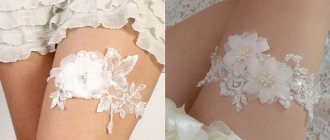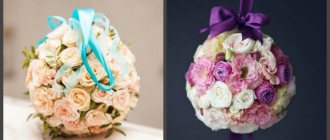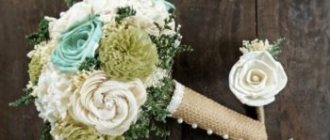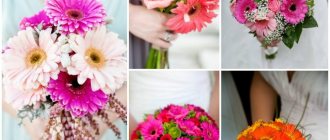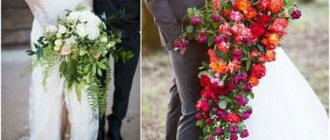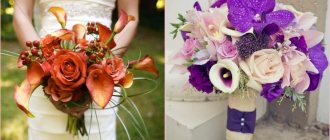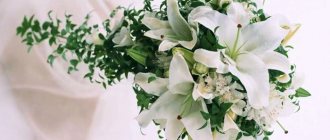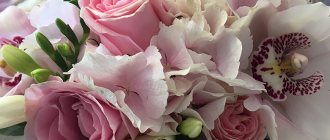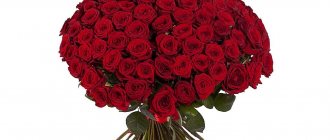Classification by shape
This classification is considered one of the fundamental ones for study; it is on it that many florists rely when composing bouquets.
Having learned to work with this classification, it will be possible to move further in the world of studying Floristry.
Round bouquet
A round bouquet is basically a spherical composition of regular shape, which is assembled from proportionate flowers with a dense arrangement. Proportionality means that flowers are selected the same in size, including buds.
At the same time, the colors of plants are not only monotonous, but multi-color inclusions and color textures are also allowed.
How to combine colors well to create a harmonious bouquet can be found in the article “Name of color with photo.”
Therefore, an important point in the execution of assembling round bouquets is the location of the material, and it can be as follows:
- Circular concentric - flowers are arranged contrastingly in a circle with such alternation, for example, as large-small inflorescences of yellow and red flowers, and with the obligatory replacement of material in a new circle;
- Spiral - a spiral path inside the bouquet is distinguished by a different shape of plants in a different color scheme;
- Structural - they try to arrange the material in groups proportionally;
- Diagonal – select opposite sectors with a diagonal and fill them.
Round bouquets can also be assembled using other modifications, which depend on the degree of skill of the florist. But in any case, this type of bouquet is the most common.
Cascade bouquet
A cascading composition is a vertical bouquet collected in a downward direction. The base of this bouquet is made in the shape of a regular triangle with the apex at the bottom, and the flowers are arranged in a special way using the following techniques:
- Placements on living stems;
- Mixed, where more than 70 percent of fresh flowers and only 30 percent of taped flowers are combined together with special wire tires;
- Placements on the portaquet;
- English installation on wire stems, completely covered with fresh flowers;
- Frame, where the base is made of birch, rattan or wire.
And the cascade effect itself is achieved using a floral arrangement, which comes in two types:
- The usual cascade-drop is a flowing composition in which long plants are located at the bottom, and short ones are laid stepwise at the top;
- A waterfall is a cascading bouquet, where the flowers are arranged exactly the opposite way, short plants are located at the bottom, and long plants in the form of a veil cover them from above.
Cascading bouquets of flowers are shown in the photo.
Frame bouquet
A bouquet on a frame is a technically complex composition of various shapes, the most common of which are a disk, an irregular spherical shape, a heart, and a cylinder.
To create a frame composition, you need to work out the concept of the bouquet itself and a competent choice of flowers that undergo certain processing. Excess leaves on the stem are removed from flowers or taping is carried out. The plants are then placed on the frame.
When creating the frame, both artificial and natural materials are used. Therefore, the basis of a frame bouquet can be either wire, greenery or branches. The assembly of the base occurs according to a pre-drawn diagram. The frame is complemented with flax, feathers, sisal, rattan and other materials.
There are many options for creating frame compositions. But frame bouquets that are more popular than others are:
- Fan – with the help of this bouquet you can create a romantic and poetic mood of the 19th century. You can decorate this floral arrangement with original antique embroidery, inserts of pearls and stones, ribbons and openwork braid;
- A muff is a cylindrical composition, which is more often collected in winter than in summer, because such a bouquet can serve not only as a beautiful decoration, but also as a practical thing and warm your hands with the help of fur placed inside the frame;
- Handbag – the main advantage of this composition is that the handbag is a favorite accessory of a woman’s wardrobe. And such a floral accessory will not only attract attention, but will make a woman stand out from the crowd.
In addition to the basic forms, the imagination of florists helps to construct bouquets of non-standard shapes, for which artificial materials such as paper, wire, tape, porta bouquet and oasis sponge, and floral glue are often used.
Among these forms, the following compositions stand out:
- Glamelia is a decorative bouquet of a cone-shaped or hemispherical shape, which craftsmen create from the petals of fresh flowers using wire or glue. To create such bouquets, petals of gladioli, camellias or roses are often used;
- A wand is a floral arrangement assembled either from plants on very long stems, or flowers secured with decorative wire and ribbon;
- Cone - flowers are collected on an oasis sponge or porta bouquet in an elongated shape and placed in paper shaped like an inverted cone.
We invite you to familiarize yourself with: Dream Interpretation Birch.
Why do women and men dream about Birch? Along with this classification by form, one should study the second specification, which is of no small importance.
Easy bouquet shapes for beginners to assemble
The shapes of bouquets are different, as are the types of floral arrangements. But it is difficult for novice florists to understand all the subtleties of design the first time.
Of course, complete information about the formation of various compositions is difficult to immediately master (it will be presented in more detail in the second part of the article). But it’s worth starting practical exercises with easy-to-use forms that can be reproduced either by reading a step-by-step master class or by repeating after the florist.
What forms are distinguished by their simplicity and ease of execution? There are several of them:
- Round shape - the flower heads touch each other on top, and the bouquet is collected in a spiral. This shape is the most popular and is easy to create from a variety of colors;
- The elongated shape is quite simple to assemble. It is assembled using parallel technology. All you need to create it is to lay the plant stems tightly together;
- The ball shape is a bouquet created on piaflora, a special floral foam. The flowers completely cover the outside of the foam and create a beautiful floral craft.
In addition to this form, many other interesting bouquets can be created using an oasis sponge. How to work with it is described in detail in the article “Floral materials and tools.”
Both adults and children can make various simple flower arrangements using piaflora. At the same time, children's floral lessons have their own characteristics.
What master classes will be useful for beginners? Let's give some useful examples.
How to make a bouquet of flowers: little florist tricks
To make not only an aesthetically beautiful bouquet, but also to fill a flower arrangement with meaning that is relevant for a particular occasion, it is important to take into account several tricks. The language of flora is very diverse: the shape, color, variety and number of flowers in a bouquet can sometimes say more than postcards with signatures or verbal confessions.
- If you take into account the gender of the person you are going to please with your creation, then it is customary to make round bouquets for women, and elongated bouquets for men.
- Flowers speak volumes: camellias and lilies are open admiration; mimosa - hidden sympathy and tender feelings; roses, tulips and white irises - love and passion; chrysanthemums and hyacinths - respect; yellow carnations - fading of feelings; orchids - the importance of communication between the giver and the giver; lilac - devotion and respect for, perhaps, past feelings.
- You need to distribute the flowers inside the bouquet according to the rules of color composition: light buds along the edge, bright and dark ones in the center.
- Asymmetrical or liquid bouquets can be skillfully played up: wrapped in one large palm leaf or rolled into a fern leaf.
- To make the bouquet look interesting not only at the time of gifting, but also to please for several days, choose buds of different degrees of maturity: blossoming, half-opened, tight.
- Exotic flowers reluctantly coexist with wildflowers: firstly, visually such a composition seems absurd, and secondly, not all flowers can peacefully coexist with others, because different varieties of plants require certain conditions.
- In Russia, it is customary to give an odd number of flowers for joyful holidays and events, and an even number - in case of mourning and expression of grief.
- To make an organic and stylish bouquet, use flowers of two or three shades. Spring bouquets are usually made from light and delicate flowers, while autumn and winter ones are more variegated.
- It is very important to take into account all the nuances: how the bouquet will fit into the intended interior or suit the outfit of the person to whom it is addressed, if you are going to present flowers directly at the event itself.
- Ribbon, wrapping paper, decorative details are no less important than the flowers themselves: the brighter the bouquet, the more laconic its packaging should be.
Before you start creating a flower arrangement, it is important to prepare the plants.
- 2-3 hours before you start making the bouquet, place the flowers in water and spray the buds with cool water from a spray bottle.
- Make oblique cuts on the stems.
- If the flowers have been stored in a cool room for a long time, let them recover a little: put them in a warm, damp place and carefully straighten the stems, leaves and buds.
- Do not tighten the bouquet with a thick layer of wrapping paper or tight ribbon: the flowers should breathe freely.
- Long stems can be cleared of excess leaves, but to prevent the bouquet from turning out scanty, supplement it with sprigs of greenery or swaddle it with craft paper.
- Many flowers are quite whimsical, so you should not take them by the buds with your hands; it is better to use disposable gloves when making a bouquet.
Rules for making bouquets
To ensure that the flowers in the composition do not conflict with each other, it is necessary to follow several rules for selecting components:
- To create a complete composition, use no more than 3 varieties of plants and some greenery.
- Do not overload the bouquet with different numbers of shades. They must harmonize and complement each other.
- When collecting a composition, it is better not to use flowers that negatively affect the “neighbors”. These are lilies of the valley, lilies, orchids, carnations, they are usually used in mono-bouquets.
- The sizes of flowers depend on the specifics of the composition. So, in small bouquets you should not use many large buds. But voluminous bouquets will not be harmonious if they are dominated by plants with small inflorescences.
Classification by style
Modern floristry distinguishes several basic styles, thanks to which it is possible to create the ideal bouquet for any life event.
Vegetative style
The vegetative composition is a complex, skillfully assembled bouquet that looks as natural as possible and close to natural conditions. Very often it is called a piece of nature, since its creation not only uses natural materials, but also takes into account the basic characteristics of the plant world.
When creating a vegetative bouquet, pay attention to the following factors:
- Asymmetrical and symmetrical arrangement of plants;
- Grouping, proportions and examples of growth in the natural environment;
- Natural color and shape of plants;
- Seasons - seasonality allows you to understand what materials should be combined.
This composition is minimally decorated, but despite this, it looks incredibly stylish and elegant.
Decorative style
Decorative style allows you to create bouquets in a single concept, sometimes from completely dissimilar materials. In this case, the plants lose their individuality, but this is more than compensated by the overall expressiveness of the bouquet.
The features of this style are the following:
- Plants should fill the bouquet tightly to the center;
- Both asymmetry and symmetry are allowed;
- Various natural and artificial materials are used and grouped together in the work;
- Color contrasts are used because color is very important in composition;
- It is allowed to combine stylistic features of different eras;
- Overall visual balance is maintained.
This style is quite bright and convenient to perform, so many florists prefer to use it in their work.
Contours, line and shape are the main elements of the form-linear style. They set the tone for the entire floral composition. In this case, an important condition for the work is such a combination of elements in which the bouquet will acquire expressiveness.
This style has the following characteristics:
- The use of many shapes and lines is not allowed;
- The form must remain clear;
- To create a bouquet you need a minimalist amount of material;
- The arrangement of the material should be asymmetrical, although symmetry is sometimes allowed;
- A combination of plant and artificial materials;
- Contrasts and juxtapositions are used;
- The bouquet should maintain space.
We invite you to read: What is a gypsy love spell and how to remove its consequences?
Bouquets in this style are very suitable for interior arrangements and various conceptual events.
Massive style
One of the clear and understandable compositional styles is the massive style, which is also called style-form. The execution of these compositions is quite simple, but at the same time labor-intensive. The shapes of the bouquets are clear, for example, a cone, a heart or a ball, the main thing is to decide on the execution technique.
To assemble massive bouquets, you can use various techniques, such as arrangement on a base, gluing, weaving, parallel or spiral assembly, and others.
In addition, when using a form style, the following is recommended:
- It is advisable to use no more than 3 types of material;
- The composition does not need a center, so the bouquet must be filled tightly;
- When assembling, you must adhere to a strictly chosen form;
- If the bouquet involves a base, for example, a vase, then it should be compositionally combined with the bouquet.
It is worth additionally noting that the development of styles does not stand still and modern floristic schools have recently sought to highlight new directions, one of which in the near future may become a transparent style.
Classification by purpose
Women's bouquet
Perhaps the most common flower arrangements are bouquets created for beautiful ladies. And no matter how old this lady is, 10 or 50, every girl, girl or woman is always pleased to receive such a gift.
Women's bouquets embody the flight of fancy of any florist, because in their composition both heterogeneous materials are used, including unusual ones, as well as various forms of composition, as well as trends.
However, despite such a variety of women's bouquets, there are some important things that should be taken into account when composing them:
- Female age - it is preferable for young girls to give flowers in pastel colors with delicate buds; for young women, richer and brighter shades are suitable; for older women, moderate colors are more suitable, where bright accents are allowed;
- The degree of kinship and closeness is one of the most important factors. Flowers can be intended for a mother, wife, loved one in one case, or an acquaintance, friend, colleague in another case. In the first option, the bouquet is created with special care and tenderness, therefore the flowers are selected that will convey all the important feelings and attitudes. In the second case, it is better to focus on classic versions of bouquets with well-known flowers, among which the most common option is roses;
- A woman’s preferences - regardless of all the rules, every woman loves flowers of certain shades, for one it is yellow, for another it is lilac, for a third it is scarlet. The same applies to the form of the composition. Therefore, it is important for the florist to know about this in order to select flowers of the desired shade and make the bouquet much more pleasant.
Men's bouquet
Men, just like women, can receive a flower bouquet as a gift. But the floral composition presented to a strong representative of humanity will be strikingly different from others.
A man's bouquet of flowers is distinguished by such characteristic features as:
- Lack of delicate colors, preference is given to bright, rich tones, for example, scarlet, blue and purple;
- Using flowers that do not smell or stain clothes;
- The use of an elongated assembly shape, pyramidal or triangular, and no round or spherical options;
- Laconic textured packaging.
In this regard, not all flowers are suitable for decorating a male composition. Plants such as alstroemeria, gerberas, callas, irises and long varieties of roses will look stylish. A good addition to them would be bamboo and holly greens.
It is also possible to add beautiful bottles with alcohol, coffee and various gift accessories to the composition.
Children's bouquet
Children's bouquets are made in the form of mini compositions. The most common types here are small bouquets, bouquets of animals or toys, for example, hares, bears, dolls, cars. Bouquets in the form of cartoon characters are also very popular.
Many flower bouquets are arranged in the form of compositions in a basket, box or bag with the addition of sweets or kinder surprises.
But the most important thing when composing such bouquets is to remember that they are intended for children, so we can highlight the following points that are important to consider when assembling:
- Children love bright colors;
- Flowers should not smell strongly so as not to cause allergies;
- Children love toys and sweets;
- The bouquet should not be heavy;
- The artificial materials used must be harmless.
When starting work on creating a children's bouquet, it is advisable to first draw a sketch and then bring the drawing to life.
How to pack and arrange a bouquet
- You can pack the bouquet diagonally by making an envelope out of paper.
- Wrap only the stems (if the flowers are long).
- Make a smooth case from wrapping paper with symmetrical edges.
- Craft paper, old newspaper, burlap, fabric, sheet music or just a piece of colored paper is a matter of taste. Anything that will complement the bouquet can be used, but will not draw attention to itself. Packaging in calm tones is preferable - the more neutral the better.
- Satin and lace ribbons, flexible plant branches, old beads, and twine can be used as paper holders.
- Notes, cards, valentines and any other paper wishes can be bought or made yourself, placed as in the bouquet itself, secured with a small clothespin or placed on the packaging.
We invite you to familiarize yourself with: Indoor plants that bring happiness and good luck to the home
We select flowers wisely
First of all, you should pay attention to such a factor as the freshness of the flowers. Many people mistakenly believe that it is better to buy a closed bud, which will then bloom, but such a flower can only be the core with the side petals already torn off.
It is worth paying attention to the petals - if they have changed color and are slightly wilted, then such a bouquet will not last the entire wedding day.
Another important factor is the type of flowers that the bride prefers. The most persistent flowers are roses, callas, freesias, lilies, orchids and daisies. However, they will not last long if the bride wants to use a bouquet on stems. The best option would be a porta bouquet holder, which can preserve plants throughout the day.
Classification by event
There are quite a lot of events in life, but there are several special ones, which are often decorated with floral bouquet arrangements.
Bridal bouquet
Making wedding bouquets is one of the most interesting creative processes for florists, because a wedding is an incredibly impressive event, in the center of which one important person shines - the bride.
And the wedding day is special when any bride wants to look perfect. And a beautiful bouquet in gentle hands will help to emphasize this ideality.
But it is worth remembering that assembling a wedding bouquet depends on the following factors:
- Wedding Event Colors;
- External type of the bride;
- The bride's favorite flowers;
- The shape of the bouquet is selected based on the style of the wedding dress;
- Harmony of the bride's image as a whole.
If the bouquet is poorly chosen and does not take into account these important factors, then the bride’s mood may deteriorate, and the entire event may not be successful.
To create wedding bouquets, florists take a variety of flowers, including hydrangeas, orchids, chrysanthemums, and exotic options. But the most popular among all is undoubtedly the rose.
More than a million times this flower with a wonderful name has been added to the composition. The rose looks great both in a mono- and multi-bouquet. Therefore, choosing a rose as the basis of a wedding bouquet, a florist will never go wrong.
New Year's bouquet
New Year is a bright holiday associated with a snowy winter, a magical mood and gifts under the tree. And New Year's compositions fully convey the spirit of this holiday.
Florists create New Year's bouquets not only for gifting, but also as elements for decorating the interiors of apartments, houses and offices.
When composing these winter bouquets, coniferous branches, both natural and artificial, are used as the main materials. They are decorated with candles, pine cones, Christmas tree decorations and balls, sweets and lollipops, ribbons and tinsel.
The compositions also contain some flowers and fruits. Among the flowers, preference is traditionally given to amaryllis, carnations, gerberas, red roses and the Christmas flower - poinsettia. From fruits - citrus fruits, mainly oranges and tangerines.
Massive New Year's compositions are collected in large baskets and complemented along with festive elements with candy boxes, bottles of alcohol, such as martini or champagne. Interesting floral greenery is also added to such bouquets, among which hypericum is the most popular.
Floristry masters also design other types of New Year's bouquets, the contents of which depend only on personal wishes and preferences.
Anniversary bouquet
An anniversary reflects an important milestone in life and is expressed as a round date in the life of a person or an important event associated with some event.
A bouquet for such an event should be original and luxurious, and symbolize a wide range of feelings, including love and respect.
If the anniversary is connected with a birthday, then the personal preferences of the birthday boy or girl being presented are taken into account. But in the absence of preferences, women choose flowers in red, white and yellow shades, such as orchids, roses, chrysanthemums and eustomas. For men, blue and blue, red and orange shades are selected.
If the celebration is associated with a significant life date, then the compositions are made in an original form, the most suitable among which would be a bouquet of a heart, a bouquet of a ship, or flowers in a hat box.
